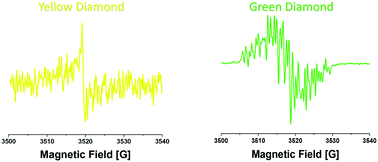Nitrogen concentration and anisotropic effects on the EPR spectra of natural diamonds†
Abstract
Paramagnetic centers in diamonds are affected by nitrogen atom contamination in the lattice. This study aimed to better understand the nitrogen concentration and anisotropy impact on the EPR (electron paramagnetic resonance) spectrum of natural diamonds (i.e. appropriate for color enhancement treatments). All the diamonds used were natural either colorless or faintly colored (D–M color range), which were selected according to the targeted final color post-treatment: green, blue, pink, orange, and yellow. Their paramagnetic centers were studied using EPR spectroscopy at various microwave power levels and evaluated for nitrogen concentration via FTIR spectroscopy. The results show a correlation between nitrogen concentrations and spin concentrations in all the pretreated diamonds, whereas the most abundant fast-relaxing paramagnetic center is similar to the C-centered radical. In addition, the hyperfine interaction anisotropy of the paramagnetic centers of nearby nitrogen atoms was found to be valid for pretreated green, pink, and orange diamonds. By clarifying the final structure of the treated fancy diamonds, which are visibly affected by adjacent nitrogen atoms, this study contributes to the refinement of colorless natural diamond selection for color enhancement.

- This article is part of the themed collection: Crystal Engineering Techniques


 Please wait while we load your content...
Please wait while we load your content...